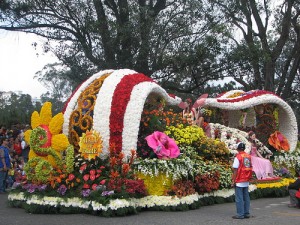My adventure in Baguio , is one that I shall never forget. It was all like a dream; I think I’ve enjoyed each day that I had no time to write in my diary. It is only now that I’m recollecting the pieces as I try to write down these things that are still vivid in my memory.

Tess, my bestfriend, was with me in many of my travels, and we were both very excited in this one. As auditors, we have been assigned to many places across the country, and it was indeed our first time to see Baguio, a city of cooler climate, named as the Summer Capital of the Philippines.
Early in the morning, the group met at a bus terminal in Caloocan City (a major city in Metro Manila). It was a six-hour ride, and just before lunch came, I just knew we were almost at Baguio as I gazed upon the great fog covering the area. (Baguio is a city in a high altitude, a plateau where you can have a good view of the surrounding scenery.) As the bus went higher up however, we came upon a zigzag road, and I couldn’t help but pray that we may arrive safely. More than the fear however, is the excitement of the days to come.

Arriving at noon, we ate at a fastfood restaurant along Session Road, Baguio. After which, we took a cab to our audit site. Later, we looked for a place to stay, as the audit site did not have proper facilities to keep us warm at night. It was a real challenge to look for lodging in the area as many hotels are already full due to the upcoming “Panagbenga (Flower) Festival”, a festival participated in by tourists and locals alike during February.
Fortunately, a kind man approached us while we were inquiring at Teacher’s Camp. He said he has a place for us at Maryhurst Road. It was already late and we really hope it would suffice. After some negotiations, it was agreed that we’d take the offer.
Upon arriving at the place, I was so glad that we took it because it looked cozy and had the facilities we needed like a hotshower, an electric air pot, extra bedding and even a television set. God had been kind to us indeed and He was not a minute late!
The next day, we immediately began our work. Carrying our working papers and other materials, we walked up the sloping road towards the main street. We did this every morning for the rest of our fieldwork! At first, it was surely not easy. In my mind, it was as though we’re doing a bit of a mountain hiking each day. But the view was really good – tall pine trees, color flowers – and the air was so fresh I really wished I could take it back home! Besides, for people who had been so used to sitting eight hours a day infront of a computer, this was a good exercise.
At the audit site, an employee cooks for our meals daily. I could really attest to his skills,which made our stay at Baguio even more satisfying. Further, vegetables in Baguio are really fresh that they taste sweet and juicy.
Once in a while, we also went to Tuba, a place just outside the city where we also have assigned tasks. It’s a bit higher than Baguio, and quite cooler. It was there that I first experienced a fog at high noon! I was like a child in awe as I watched the fog get nearer until I was virtually swallowed by it. Swallowed by the clouds indeed, who wouldn’t feel like she’s in heaven? The sun was shining through, and the day’s perfect! We even took pictures of ourselves at a nearby park. In the afternoon, while in Tuba, we make it a point to finish our work early and leave at 5pm. That’s because the fog already gets thick by that time and few vehicles are available also to take us back to the city. Besides, it would be very hard to work with all that fog in the way, we’d hardly be able to read as the fog enters the office premises (maybe due to broken windows or lack of proper facility). Tuba was known for that fog, that’s why it’s also known by as “Bahay ng Ulap” or House of Clouds (Fog). They say that in the wet season, it rains almost everyday there.

One time, we shopped at the town’s market (in Baguio), and bought some sweaters, bonnets and gloves. We really laughed at ourselves since we were the only ones wearing gloves in the area. I guess the locals have gotten used to the cold, especially at night. I even saw ladies wearing sleeveless clothes and spaghetti straps.
Before that, Tess and I also shopped for some groceries and explored the area. We passed by Burnham Park on our way to the market. There, one could easily rent some boats to while away the time and spend a romantic evening at the lagoon.

It was already dark when we got home and it was freezin’ cold (at least for me). Every night, we took a cab to Maryhurst since we rarely made it for the last jeepney ride of the day. Most of the time, we met kind drivers. One night though, we encountered someone who is rather weird. He didn’t take the same route and we were afraid we’d get lost. He also kept on talking in a language no one among us could understand. I prayed hard that we may be protected from harm, and I was relieved when we finally made it safely to our place.
On another evening, we experienced a brownout at Maryhurst. It was a good thing I’ve brought my flashlight with me because I wasn’t really comfortable in the dark. Usually, I couldn’t breathe well, and I get scared. Nice thing I was not alone that night. Tess even asked me to tell her a story before we sleep. Soundly then did we sleep.
During weekends, we were able to stroll around Baguio more. My sister Apple even came with a friend to join us one time.
One morning, we decided to try a little horse back riding. My! It was the first time for me. I was afraid I might fall, or the horse may get wild (even if it almost looked like a pony). Well, I just tried to rid myself of all those fears and enjoyed the ride. We just went around the park and felt this kind of relaxation we rarely feel in our stressful workdays. After some time, I think I’ve already gotten used to it and felt more confident, I never knew I could be as confident! Maybe when I practice hard enough, I could even become an equestrian, haha.
Our next stop was at Minesview Park. In Baguio, it is there where you can get a clear view of the mountains and of the mines below. One can even rent binoculars to get a better view of the scenery. Tess and I bought some grilled squid and some grilled corn as we strolled around. It was a relaxing afternoon, and it was nice that we spent it there.

One Sunday, we went to the convent of the Sisters of the Good Shepherd and attended Mass there. Though we didn’t understand some of the words and songs, I felt the solemnity of the celebration. Truly, love and peace has only one language. Same is true with music.
After the mass, we bought some Ube and Strawberry Jam sold by the sisters. And bookworm that I am, I was also able to browse in their bookstore and buy some books to read later.
We also went to see the Philippine Military Academy (PMA) parade. The President was there too, to witness the event! The cavaliers looked so gallant in their uniforms I could almost fall in love with one, haha.

After the parade, we shopped around and bought some souvenirs like keychains and calendars. We also learned of some of their traditions there like the “Flirtation Walk”, a place where a cavalier must win his lady’s heart before the romantic walk was over. I couldn’t help but wish one would someday propose to me in a place like that!
In our Baguio travel, we also witnessed the “Street Dancing”, a prelude to the “Panagbenga (Flower) Festival” where different groups compete to win Best Street Dancing category.
Before the contest itself, there was a parade of all the contestants. We were lucky enough to have a nice spot to see the event. (And that spot is somewhere where we can stand on top of a wall to get a good view of the parade!) The dancers were magnificent, especially the young ones who were so energetic executing their steps. Dressed in colorful costumes and performing to the best of their ability, it was really a sight to watch. I’m just glad none of us fell off the wall while doing that!
Finally, the Parade of Floats. It was there where different floars compete with each other during the “Panagbenga”. Each float used hundreds, even thousands of flowers to create a design of their choice. Some floats were shaped like animals, one like a giant ice cream vendor, another like a flag, still another like a chariot, etc. It was all too wonderful to see! After the parade, those floats were exhibited at Burnham Park and in the evening, a huge bonfire was made to continue the fun and the party.

My sister and I also went to Camp John Hay and the “Panagbenga Market Encounter”. There, we found exhibits of all sorts to highlight the beauty of flowers and plants. I bought some seeds of flowering plants and gave one later to my friend. Apple and her friend also rented some roller blades in a skating rink nearby.
After all the festivities, we thought we’ve seen it all. One of our groupmates however reminded us that we haven’t been to the Botanical Garden yet, which incidentally was very near our lodging house. So before we went home, we went to see the place. There, we took pictures of ourselves with native Igorots (Native people in Baguio) in full costume! We enjoyed the varoius flowers there, and the place itself. Tess even bought some cactus plants.
We also passed by “The Mansion”, the President’s place of residence when she’s in some official business in Baguio.
Last stop was Session Road. There, we found that the road was closed because of the “Panagbenga Festival”. It was wonderful, because instead of vehicles, people are all over the place. There were booths of all sorts that it all seemed very much like a Fair. There were face paintings, books, flowers and souvenirs for sale. There was such a merry atmosphere that we could have easily opted to stay longer were it not for our departure schedule back to Manila.
I paused for a moment and counted once more the many blessings God has given me, things I often took for granted, things many people like me ignore.
Everyday, the world seems to tell us so many things we should grieve about. So many reasons why we should not be happy. But why dwell on these things? If the world asks us why we should be happy, let us ask the world, “Why not?”








